I’ve just returned from a fantastic trip to North Sulawesi, Indonesia. Over the years, I’ve watched this area grow from a relatively unknown destination to one that’s now arguably among the top dive destinations in the world. People travel from across the globe to dive here. I’m lucky. Being based in Singapore, this world-class dive destination is practically in my backyard!
On this trip, I had a chance to visit three key areas in North Sulawesi — Manado/ Bunaken, Lembeh Strait, and Bangka. And as usual, I took many notes along the way, some of which follow:
Camera Woes
Everything was going really well my first day in the water — until I got back to the resort and downloaded my images. To make a long story short, every single image taken with my new 1Ds MkII had thousands of vertical lines drawn through them, almost like a corduroy pattern. Major, major, major bummer.
So there I was, staring at corrupted images on my laptop screen at 9:30 pm. It wasn’t like I could pop down to the neighorhood Canon service center (even if there was one in Manado).
First came anger: This was a brand new camera…and a %$#%* expensive one at that. It was a top-of-the-line Canon. This was not supposed to be happening. But it was.

Then came panic: It was the first day of my trip. I had another camera body, but there were a lot of images I wanted to take that I wouldn’t be able to without this particular camera. Oh *#^@#$!
And finally came rational thought: After a flurry of sms-es, I got a tentative diagnosis from Canon (probably a bad processing board), and I also managed to secure a replacement camera.
The next day, with the help of the terrific team at Murex Dive Resort, where I was staying, I sent my malfunctioning camera to Canon for repair. Sigh.
In the meantime, the major “overnight” courier services (Fedex, UPS, DHL) said that they require at least a week to get a parcel (containing my replacement camera) from Singapore to Manado, and even then without any assurance that they would actually deliver before I leave Indonesia.
There are four direct SilkAir flights weekly between Singapore and Manado, yet Fedex, UPS and DHL combined couldn’t get a package to me in less than 1 week. "Overnight" indeed. What's that line about "When it absolutely has to get there..."?
Luckily, with another flurry of sms-es, I was able to arrange for the camera to get on the next SilkAir flight, so by the end of the week, I was back in business — 5 days of photography lost to camera problems and incompetent couriers.
Back to Basics
While all this was going on, I managed to set my aggravations aside and get in a few dives with my remaining camera — a Canon 5D with a Zillion housing.
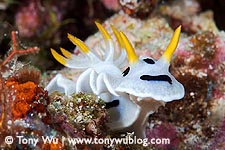
When I first dived Manado many years ago, I fell in love with the macro life — the zillions of small critters going about their daily life, providing plenty of excellent photo opportunities if you take the time to look.
With only one camera in hand, I decided to go back to basics — to dive with only a 100 mm macro lens. Nothing fancy — no wide-angle, diopters, converters, extension tubes, filters…just a basic macro lens to look for critters.
It was annoying in a way, as I didn’t have the flexibility of having more than one perspective to work with, but then again, it was unexpectedly liberating too, as I could concentrate completely on the one lens that I had.

This was the first time I took the 5D down for macro photography, and also the first time I used the Zillion 5D housing for macro. I attached a port converter to be able to use my old Nexus 105 AF port, and added a couple of Inon Z220s strobes.
The entire set up is really light (the housings are made of ABS plastic), and since the strobes are triggered via fibre-optic link, there are no strobe sync sockets to flood — meaning rapid set-up and disassembly time.
Highlights during my single-camera handicap dives included my first time diving in front of the Manado Megamall — an excellent muck dive that rivals Lembeh — and diving the Murex house reef, which is packed with interesting critters.
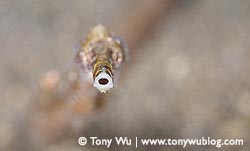
I also continued my recent obsession of taking photos of fish with their mouths open. Perhaps the most challenging image from these couple of days was taking a head-on shot of a pipefish with its mouth open. From lining up the shot and waiting for the elongated fish to open its mouth, to focusing on a tiny target and lighting the whole thing correctly…I felt like Luke Skywalker lining up for the single shot to destroy the Death Star. My unfortunate dive guide Basrah of course was bored to tears while waiting for me waiting for the pipefish. Maybe he wasn’t a Star Wars fan.
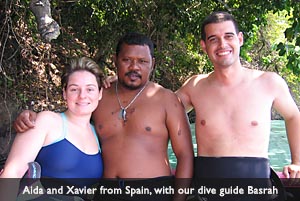
Finally, I was lucky to dive with a lovely couple from Spain — Xavier and Aida. Actually, they were in the seats next to me on the SilkAir flight from Singapore, then in the same transfer van to Murex, and finally in the same dive boat. It’s almost as if we were destined to spend a few days together!
I couldn’t have asked for better boat companions. Xavier and Aida were great divers, and they always seemed to be in a good mood.
A Bit About Bangka
One of the main objectives I had for this trip to North Sulawesi was to dive around Bangka Island. Most divers are familiar with the names Manado, Bunaken, and the Lembeh Strait, but many people probably don’t realise that there are other islands north of the Sulawesi mainland; even those who know that there are other islands may not have taken the time to dive in the area.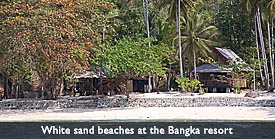
There are quite a few islands in the north, with Bangka being the biggest. Gangga Island is nearby too. Above water, the most striking thing about these northern islands is the many white sand beaches. Most of the beaches are uninhabited, with some being occupied by villages, and only a few by resorts.
After my stay in Manado, I moved to Murex’s Bangka Resort, which is a small beachfront resort comprising five cabins set among coconut trees and lovely white sand. The accommodations are basic, with no hot water or aircon.
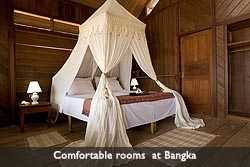
There’s always a cool breeze, so I found that I didn’t really miss aircon too much. Lack of hot water generally doesn’t worry me either, though I wouldn’t complain if hot water were installed!
With a small facility like this, you get to know the other people really quickly. During my brief stay, I shared the resort with a nice couple from France and a wonderful Dutch/ Belgian couple. The mood was relaxed and enjoyable, particularly meal times, when we had lots of fun sharing stories.
Diving Bangka
Diving in Bangka was a welcome respite from the sites in Manado. In the past few years, Manado has deservedly become one of the most popular and most well-known dive destinations in the world. The consequence of fame, of course, is a lot of attention. The number of resorts, boats and visitors has increased exponentially, meaning that there are almost always a lot of divers around, whether in the water, on land or during surface intervals.
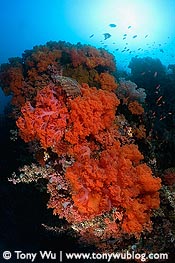
Bangka isn’t a household name yet, so it’s still relatively secluded and quiet. The facilities that do exist here are small, and liveaboards that pass through tend to stay for only a day or so.
Underwater too, Bangka is different from the more well-known places in North Sulawesi. For instance, many sites (especially the underwater pinnacle at Sahaung 1) feature brilliant red and orange soft coral.
The currents can be strong at times, bringing lots of nutrients to nourish these filter feeders. In fact, diving sites like Sahaung 1 without current isn’t really a great idea. You’ll have an easy dive, but many of the soft corals will be deflated and as limp as wet noodles. It’s better to dive when there’s a bit of current, so you can see the complete range of lush, fully inflated soft corals.
Probably because there aren’t as many divers visiting this area as other places in the region, many of the sea fans here are mostly undamaged. In fact, I came across more unspoiled large sea fans here than anywhere else in North Sulawesi.
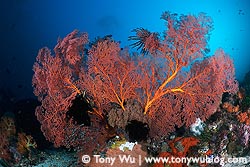
Though Bangka is still relatively untouched, the number of divers visiting the area is increasing steadily (with new resorts being built and several new liveaboards plying the local waters), so hopefully divers who are lucky enough to dive this area will take extra care not to damage the beautiful corals.
Other sites in the area like Batu Mandi, Tanjung Pulisan and Sabora feature reefs with abundant coral and fish life, while Paradise Pier has excellent muck diving.
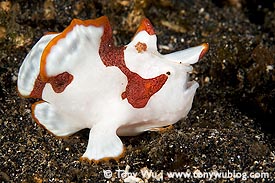
At Paradise Pier, there’s a thick rope at about 17 metres that’s packed with miscellaneous critters. One of the cutest I found was a teeny little orange-red frogfish that blended in perfectly with the sponge it was sitting on. I also found a strange crab of some sort. I think it’s an arrow crab, but I’m not really sure. It was missing one leg on its left side, and moved in a dorky, spastic fashion. Otherwise, there were sea robins, seahorses, lionfish, moray eels, flounder, stingrays, ghost pipefish…
If you’ve been to North Sulawesi many times and are looking for something different, a visit to Bangka is definitely worthwhile. You can also stay at nearby Gangga Island Resort to dive the same sites. Stay a few days if you can, and hit Sahaung 1 and Paradise Pier a couple of times at least. I wasn’t able to visit all the sites, but of the ones I did see, these two were my favourites.
Makan Time
One of the best things about diving in this area is the food. Traditional Minahasan food is quite spicy, which is terrific, since I love spicy food.
Last time I was here, I learned from local fishermen how to make a dish called Gohu, which is raw fish with lime, basil, garlic, chili, shallots and a bit of seasoning. Mmmm, mmmm good.
This time, the cook at Bangka resort was fantastic. Every night was a feast of Minahasan food, and there was one dish she made that I particularly liked. It’s difficult to describe, but it’s like a spicy beef curry, though not a thick curry, but more like a water-based spicy beef dish with curry-like consistency…if that makes any sense at all.
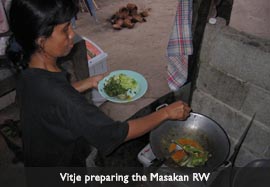
After pigging out on this dish one night, I asked what it was. The local name for the dish is Woku (also known as Masakan RW), which is actually traditionally prepared with dog meat (“RW” being the local term for dog). Gag. Fortunately, the Woku that we had wasn’t dog (I was quick to double check that!).
Much to everyone’s amusement, I asked the Vitje, the resort cook, to show me the ingredients, which she did, and then she even kindly offered to show me how to make Woku!

I watched, took notes and even photos, but I haven’t had a chance to try this on my own yet. Next opportunity I have to go to a wet market to find the correct ingredients, I’ll give it a go. In the meantime, here’s the recipe for anyone who’s interested (Take note of the highly precise measurements required):
Recipe for Woku (Masakan RW)
1. Make chili mix: Grind shallot/ red onion, garlic, ginger, lemongrass, galangal (lengkuas), turmeric (kuning), and red chili into a thick paste. Set aside for Step 4.
2. Prepare beef: Cut into small pieces and boil, then set aside and let sit in own broth until Step 6.
3. Fry a couple of stalks of lemongrass in oil for a few minutes to add flavour to oil.
4. Add chili mix and stir for a couple of minutes.
5. Add pandan leaves (cut into short segments) and stir for a couple of minutes to add more flavour.
6. Add prepared beef and some of the broth.
7. Add some water, cover and simmer 10-15 minutes until beef is tender. Stir occasionally.
8. Let sit until ready to serve
9. Heat and add finely chopped green onion, lime leaf, basil just prior to serving.
Actually, I meant to take a photo of the dish before eating most of it, but it smelled so good, and I was so hungry that I forgot to take the photo until there wasn’t much left. Burp.
Camera Update
As I left Bangka, I received news from Singapore that my 1Ds MkII is all better. Whew.
Mucking Around
I’ve been diving the world-famous Lembeh Strait now for about a week…and what a fantastic week it’s been!
The Lembeh Strait is a relatively wide channel of water that separates Lembeh Island from the North Sulawesi mainland. At first glance, it doesn’t appear to be much. In fact, it looks rather dark, dirty and cold. The main port of Bitung is located in the Strait, and fishermen of all description come and go continuously from this area.
It’s only upon entering the water that you discover the hidden secrets below. Since the first dive resort was built here in the 1990s, the Lembeh Strait has gradually become synonomous with excellent muck diving. Critters of all description (as well as many that defy description) abound here. For divers interested in observing, photographing and video-ing strange creatures, Lembeh is arguably one of the best places in the world to visit.
Which is why I was kind of shocked when I realised I haven’t spent an extended amount of time in Lembeh for about nine years! I’ve dived the area for a day or two here and there over the past several years, but this is the first time since 1997 that I’ve had a chance to dive continuously for a week and concentrate on critter photography.
Luxury in Lembeh
My visit to Lembeh was courtesy of the new Kasawari Lembeh Resort. I have only one thing to say — Every dive resort in the world should be like this! In all seriousness, Kasawari is one of the best dive resorts I’ve ever visited.
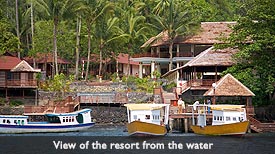
Over the years, I’ve dived all over the world, and I’ve been fortunate enough to visit some awesome destinations. Like most dive travellers, I go to far-flung places to see marine life, and I’m accustomed to putting up with minor inconveniences — from crappy airlines to less-than-ideal accommodations, and everything in between. As long as I see what I’m looking for, I’m quite tolerant.
Staying at Kasawari, however, was a sheer joy. First, it’s a boutique resort, with only 10 cabins, for a maximum of 20 guests. To call the accommodations “cabins” doesn’t quite do them justice though. They’re more like “villas”, something you’d expect from a luxury resort in Bali or the Maldives. The rooms are spacious and extremely comfortable, with large bathrooms, an outdoor shower, and wonderfully hot water (an absolute must for diving Lembeh).

Second, the resort is specifically geared toward photo and video buffs. The camera room is the biggest I’ve seen anywhere — 17 workstations, each with two charging points and a storage shelf. Even with all my gear spread out in the usual chaotic clutter, there was plenty of space — so much so that I felt obliged to make an even bigger mess than normal.
Here’s the kicker — the resort has a very well thought-out system of placing your camera gear in baskets. The dive crew take your cameras to and from the dive boat in the baskets, where they’re locked down into custom-built racks to hold the baskets — no worrying about camera parts flying everywhere! And after the dive, the crew bring the cameras up to the enormous dive platform, where they dunk your gear (still in the baskets) into huge freshwater rinse tanks! When you want to work on your cameras, the crew carry your cameras (again still in baskets) to the camera room for you.
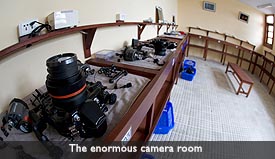
This is without doubt the most organised, most well thought-out system I’ve ever come across for handling camera gear — absolutely second to none. No worrying about cameras slipping all over the boat, being stepped on by some clutsy co-diver, being accidentally dropped into the deep blue during transport, becoming encrusted with salt and marine life due to lack of freshwater…all the things you usually have to worry about when dragging around delicate and expensive camera gear.
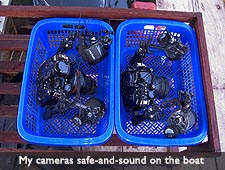
The system worked so well that I barely had to touch my cameras except while underwater and during the evening when charging batteries and downloading files. Ahhh…if only it were so easy everywhere else! I could really grow accustomed to being this pampered. 😊
Kasawari Lembeh Resort has just recently opened for business, so it wasn’t full when I was there, but mark my words — with the unparalleled quality of facilities and service, by this time next year, you’ll have a hard time getting a room.
Critter Paradise
The main reason people come to Lembeh is, of course, the critters. There are critters of every possible type, shape, and form. For photographers and u/w video buffs, this place is paradise.
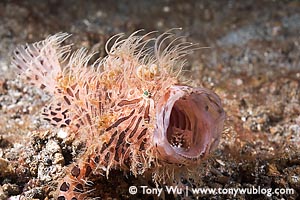
Want frogfish? There are painted frogfish, clown frogfish, hairy frogfish, striated frogfish, giant frogfish, and probably more. Want sea moths? They’re everywhere. Pygmy seahorses? Pick a colour. Rhinopias? Frequent sightings. Nudibranchs? You’ll see a dozen species or more on some dives.
The marine life in Lembeh Strait also seems to “perform” more often that in other places. You’ll find animals hunting other animals, mating, guarding eggs, and just generally doing stuff. It’s almost as if they know that everyone’s carrying a camera and wants to get interesting images or video footage.
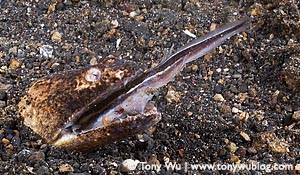
The only drawback if there is one to diving here is that the water is a bit colder than elsewhere. My dive computer usually showed 26-27º Celsius, but it certainly felt much colder. With black sand and muck on the bottom, it’s generally dark, so psychologically, you probably end up feeling colder than it actually is. If you visit Lembeh though, I’d recommend a 5 mm wetsuit and a hood, especially if you plan to stay a few days.
The typical schedule at Kasawari goes something like this:
06:00 light breakfast/ coffee
07:45 first dive
09:30 breakfast
10:30 second dive
12:00 lunch
14:30 third dive
17:00 mandarinfish dive (when enough people want to go)
18:00 night dive (when you want to do a night dive)
By 20:30 or so, I was so zonked that it was all I could do to keep my eyes open. Downloading several GB of files and sorting through to delete the ones I didn’t need usually took me to about 22:30. I found myself longing for the good old days of film when I could just pass out in peace without feeling guilty about not having downloaded and sorted all my images for the day. Sigh.
Crossing Paths
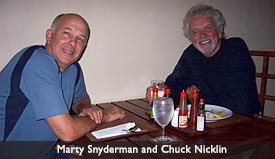 An extra bonus for this trip — I crossed paths with two very well known dive personalities from the US, Chuck Nicklin and Marty Snyderman. I’ve known both their names for many years, but it was the first time that I’d had a chance to meet them, and they were both wonderful people! We got along right away, and my only regret is that we didn’t have more of an overlap to exchange stories and talk shop. If I’m lucky enough to share another trip with either of them, I’ll be very happy.
An extra bonus for this trip — I crossed paths with two very well known dive personalities from the US, Chuck Nicklin and Marty Snyderman. I’ve known both their names for many years, but it was the first time that I’d had a chance to meet them, and they were both wonderful people! We got along right away, and my only regret is that we didn’t have more of an overlap to exchange stories and talk shop. If I’m lucky enough to share another trip with either of them, I’ll be very happy.
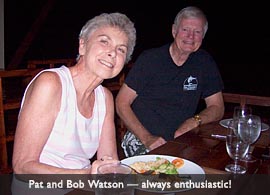
And I also met a terrific couple from the US — Bob and Pat Watson. After all these years of diving, it’s easy for me to get a bit blasé about the diving and the animals. Diving with Bob and Pat, who were just so incredibly enthusiastic about each and every dive and every single critter we came across, I realised that I had been taking things for granted. Their unbridled enthusiasm was infectious, and I found myself enjoying the dives more than I have in many years. Thank you Bob and Pat!
The amazing thing is, Bob and Pat are in their 70s. Yes, that’s right. They’re both in their 70s, are retired, and are as active as people half their age. Speaking of which, Chuck Nicklin is 79 years old. He’s a fit as a race horse and going strong.
Bob, Pat, Chuck — you’re all an incredibly positive inspiration, and I hope I’ll be as active as you are when I’m in my 70s!
Archipelago Arrives 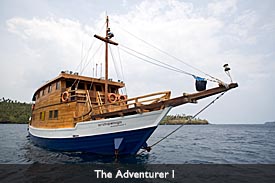
Finally, I had a chance to spend some time aboard a new liveaboard boat called the Adventurer I, which is part of the Archipelago Fleet. The best way to characterise the vessel is as a boutique liveaboard. It’s designed for a maximum of eight passengers, and has a unique value proposition. Basically, there’s no fixed schedule, so you can hop on and off the boat when you want, and you can dive whenever you want. Total freedom to decide what you want to do, when you want to do it.
The Adventurer I only cruises within the Lembeh Strait, so it’s essentially a floating dive platform with very nice accommodations (aircon, toilets, and shower with hot water in every room) and incredibly delicious food (the chef is young, but geez can he cook a mean meal!).

This boat is perfect if you’re a small group of friends who wants to dive Lembeh, have a bit of privacy to hang out with your buddies, and go wherever you want in the Strait without having to worry about compromising with other guests, all while enjoying very nice accommodation and food.
Ronny and Samuel, the two main guides on the boat, have been diving the area for well over a decade each, so they know the waters like the back of their hands. On the first dive we did, I casually suggested that it would be cool to find a giant frogfish. We went to one of the popular sites, and even though there were a bunch of divers milling about already, Ronny and Samuel actually found a giant frogfish for me…no one else knew it was there! Amazing.
Back to Reality
So after all the fun and games, I’m back in the real world. The first thing I saw in the newspaper on the plane back to Singapore was that North Korea had allegedly detonated a nuclear device. Oh joy, another nuclear arms race.
I had the sudden urge to turn right back around and stay in North Sulawesi.
Earlier today I picked up my 1Ds MkII, which now has a new processor board. I'll shoot a few images over the weekend to make sure everything's ok.
I've posted a few images from this trip to Flickr, and as the days go by, I’ll do my best to post more. I have so many nice photos from this trip though, it’s probably a hopeless endeavour.